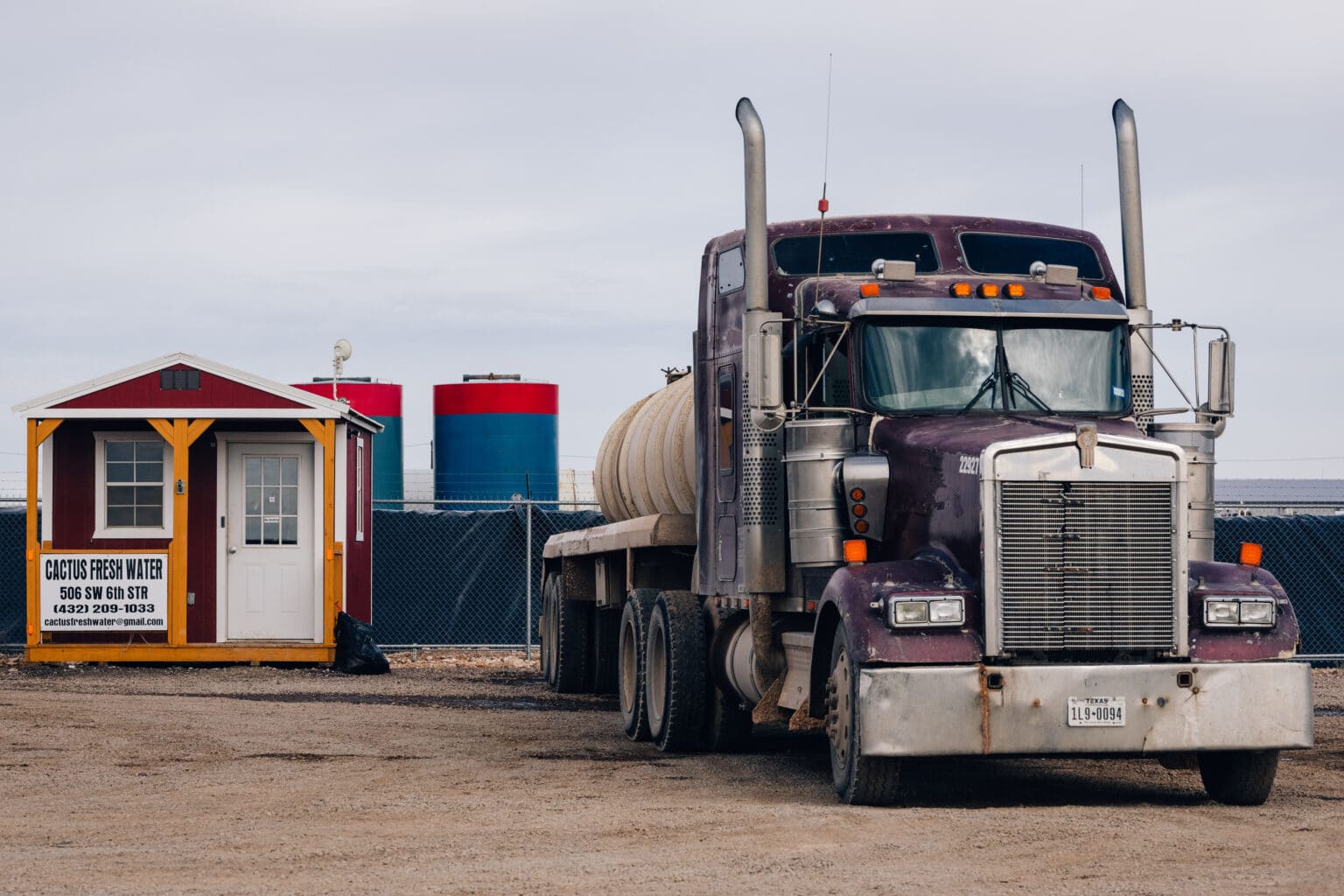At 8:00 a.m. Eastern on January 21, a magnitude 3.4 earthquake shook Culberson County in West Texas midway between Odessa and El Paso, the U.S. Geological Society reported. That’s the kind of earthquake that’s generally strong enough to be felt, but not rattling enough to cause damage.
Texas is not known for its seismic activity – or it wasn’t historically. Nearly 4,000 quakes, the majority relatively minor, have swarmed the oil-rich state over the past year. The most powerful among them was a 4.5 magnitude quake that rattled Midland in late December, tying for the second-strongest in a decade.
But those quakes themselves are just one sign of an oceanic problem confronting Texas: what to do with the billions of barrels of toxic wastewater, mixed with salable fossil fuels, that the oil and gas drilling industry pumps out each year? Texas’s seismic problems likely stem from injecting that water back underground using saltwater disposal wells – an echo of similar issues in Oklahoma years ago. The quakes have even spurred the typically inert oil regulator the Texas Railroad Commission to order dozens of disposal wells to suspend operations.
The flood of wastewater rising from below the desert could prove to be trouble for the Permian Basin drillers of West Texas, with problems plaguing giants like Chevron and tiny wildcatters alike. Some companies, including Chevron and ConocoPhillips, “stand to lose upwards of 50% of their disposal capacity in key” drilling areas, now that disposal wells suspected of causing quakes are offline, OilPrice.com has noted.
Just trucking that wastewater to other injection wells could add over $200 million to Permian drillers’ collective expense columns, the Wall Street Journal reported. “Our costs are going out of sight,” Pharaoh Oil and Gas owner Gary Bolen told the Journal. “It seems like you’re making some money, but you start getting kicked in the face in some other ways.”
“Are we really producing hydrocarbons or are we really producing water?”
Jeff Wilhelm, energy industry supplier vice president
With water pressures building, some politicians in the arid region are promoting plans to turn that toxic waste into a commodity, rather than a waste product. However, experts warn that the kind of technology necessary to dependably and affordably remove contamination — ranging from corrosive salts to carcinogens — from oilfield “produced water” simply doesn’t exist.
Meanwhile, Permian oil can’t flow if there’s nowhere for water to go, industry experts say.
“Water can’t be flared or compressed. You’ve got to be able to get rid of it, generally via disposal or recycling today. If you don’t, you’re shutting in production,” Justin Love, CEO of the wastewater firm Blackbuck Resources, said at the oil industry’s Hart Energy Water Management Conference last May. “There’s no option, there’s no relief valve to, say, flare gas and keep things moving. So it’s a really critical part of the overall process of producing hydrocarbons.”
‘Mid-Stream’ Industry
Oil is a watery business, especially in some parts of the Permian. There, every barrel of oil is accompanied by as many as 10 barrels of wastewater, a blend that’s laden not only with grease and crude oil but also with radioactive materials, carcinogens like benzene, and enough corrosive salt to render “produced water” saltier than the ocean. It can be a blend of water companies blast into oil wells during fracking and water that’s been trapped underground alongside oil and gas for millennia.
“You always ask yourself, are we really producing hydrocarbons or are we really producing water?” Jeff Wilhelm, vice president of the energy industry supplier DistributionNOW, said in May at the Hart Water Management Conference. “And to be quite frank with you, we see what, 90, 99, 95 percent water cuts on some of these applications? To be honest with you, we’re managing water on a day-to-day basis, we’re not managing hydrocarbons.”
And as a shale well gets older, the blend from the well tends to get more watered down. “Everyone wants the oil from a well but what they actually get is anywhere from 4-10 times as much water as oil,” PB Oil & Gas, a magazine published by the Permian Basin Petroleum Association, reported in May 2020, “depending on the basin and the age of the well (water cuts tend to increase as a well’s oil production decline curve plays out).”
An entire industry sector — estimated by analyst IHS Markit at $33.6 billion in 2018 — has sprung up to handle that wastewater, calling itself the water midstream industry (echoing the label used for oil and gas pipeline companies who deliver fossil fuels from “downstream” drillers to “upstream” refiners.)
Drilling and fracking also require vast amounts of water, and drillers often use some of the industry’s water for more fracking, a process they call “water recycling.”
But that kind of recycling is challenging to manage, since wastewater is produced in surges and because demand depends on a constant drumbeat of more drilling. The pandemic threw a major wrench in those gears, with the Permian rig count plunging from over 400 in January 2020 to 125 rigs that July.
Even when drilling is going strong, there’s far more wastewater than demand from the drilling industry. “You basically use one barrel of water to frack for every barrel of oil you take out of the ground,” Jason Jennaro, CEO of Breakwater Energy Partners, which operates a commercial water recycling plant in the Permian, estimated to The Houston Chronicle last November. “And then you produce on average three barrels of water for every barrel that comes out from that well.”
The water that’s not recycled — most of it, by far — is generally bound for an injection well. And that’s the process that’s linked to the worrisome rise in earthquakes shaking the Permian.
Even before the pandemic, water pressures were building for the industry. “The amount of water that we’re getting from our producing wells versus the amount we’re using to frack a well on a daily basis can be way out of whack, right?” one attendee at the Permian Basin Water in Energy conference asked panelists in February 2020. “So how do you manage that piece?”
The numbers show that for all the talk of recycling, the vast majority of wastewater is headed back underground. In 2021, about 1.9 billion barrels of U.S. shale wastewater were treated for recycling, Rystad Energy estimates, adding that this volume will grow to over 2.2 billion barrels by 2026.
But the amount of untreated water left over? Rystad estimates that will “reach an all-time high of 20.9 billion barrels in 2022 and then steadily grow to 21.6 billion barrels in 2026.”
Water, Water, Everywhere — But Not Enough to Drink
That flood of fluids sloshing around in the oilfields creates an especially difficult conundrum in arid regions, where water stress is made worse by climate change and droughts. Texas’s 2022 State Water Plan, released by the Texas Water Development Board, projects water demand in the state will rise 9 percent over the next 50 years — but the state’s existing water supplies will decline 18 percent.
“I’m told that there’s an ocean of water under Texas, it’s just not all fresh,” Kathleen Johnson, director of the Texas Water Development Board, said to oil industry representatives gathered at a 2020 conference.
Politicians from water-stressed areas have begun eyeing shale wastewater, trying to figure out if there are ways to use that instead of freshwater under some circumstances. “We cannot continue to throw 8 billion barrels of water back down a hole when I’ve got communities begging for water,” Texas state congressman Drew Darby said at the same event, referring to the practice of injecting oilfield waste underground in saltwater disposal wells. “No longer can we do that. And so what does it take?”
The simple answer is water treatment — but treatment itself is far from simple. Shale wastewater can carry a proprietary blend of chemicals used in fracking, radioactive materials found naturally deep underground, and even, perhaps, illegal additives like diesel fuel. Drillers often distinguish between “flowback,” wastewater produced soon after fracking where additives are more concentrated, and produced water, which tends to carry fewer additives.
Nonetheless, some farmers and ranchers in the Permian region have begun eyeing oilfield wastewater. “If we could just convert that produced water to an agricultural water standard, we can create new fields of alfalfa and cows,” Brent Van Dyke of the New Mexico Association of Conservation Districts said at a 2019 water conference, Searchlight New Mexico reported.
But scientists like Bridget Scanlon, a hydrogeologist and senior research scientist at the University of Texas at Austin, have warned that shale wastewater is a tricky brew. “We don’t know as much about this” compared to other sources of water, she told the Texas Tribune in January. “At the end of the day, you need to have confidence in what you are doing.”
A 2020 scientific paper published by Scanlon concluded that it would require “much more research” into how to treat the water before drillers could “safely” take oilfield water and sell it to buyers outside the industry, noting an array of related issues like potential liability and a lack of regulation.
Still, the push to use oilfield wastewater remains strong. “I think reuse is in our future outside of the oil field,” Mark Patton, president of Hydrozonix, a company that’s marketing evaporation systems for oil and gas wastewater, said in May at the Hart water conference. But he acknowledged that contamination was an issue, suggesting that required testing for everything in the water would be a nearly insurmountable barrier — and an idea “which really scares me.”
“And the reason I say that scares me is that there’s going to be compounds that we’re going to identify and byproducts that we’re gonna identify that’s gonna be — take years to do that, and then most of these don’t have test methods. So we’re gonna wait, what another 20, 30 years for the test methods to be developed?” Patton said. He claimed that there are “general toxicity tests you can do,” suggesting those could be a short cut.
“Any reuse of Permian produced water in a way that puts untreated or minimally treated produced water into the environment unnecessarily risks harming human health and the environment,” Alex Ortiz, a water resources specialist with the Sierra Club’s Lone Star chapter, told DeSmog.
“It’s an unnecessary risk,” Ortiz said. His organization supports re-use by the oil and gas industry, he explained, but does consider it important to understand what’s in the water before using it for agriculture or in ways that could affect people or wildlife. He emphasized that the wastewater can contain radioactive materials and that it wasn’t clear that “general toxicity tests” would capture long-term health hazards.
Some in the oil and gas industry aren’t quite convinced that treatment technologies seem ready for game day.
“All of us would be thrilled if we could use this water for beneficial reuse,” Gregory Mullin, a Solaris Water Midstream executive, said at the Hart conference last May. “The technology to clean it for beneficial reuse is there, but it’s really how do you get rid of all the heavy salts and all of the metals and mineral that are involved in that — that would be in my opinion the biggest quandary that we face in actually getting to this beneficial reuse.”
Texas has begun exploring options.
Last June, Texas passed a law launching the Texas Produced Water Consortium, an effort by government and industry hosted by Texas Tech University. That consortium plans to produce a report by September 2022 that will suggest regulatory changes that could help pave the way for reusing oilfield wastewater for activities such as irrigation or industrial cooling, Global Water Intelligence reports.
Already, lawyers have begun debating not who is liable for handling Permian wastewater, but who gets to own it if it’s considered a commodity — landowners or drillers?
Blowout! pic.twitter.com/THUWX5L3tb
— Russell Gold (@russellgold) January 12, 2022
Meanwhile, below ground, oil industry water has begun wreaking an entirely different kind of havoc on Ashley Watt’s cattle ranch in Crane County, Texas. A geyser over 100 feet high of oilfield water erupted from the middle of the desert landscape just as 2022 kicked off, crusting the sands of Watt’s land with corrosive salts and soaking the ground with an estimated 25,000 barrels of water a day.
The incident apparently troubled federal regulators enough that they declared a temporary no-fly zone over the area. Chevron, the oil giant that owns aging wells drilled on Watt’s ranch, managed to cap the geyser on January 17 — but it’s not yet clear exactly where that water came from, how it got there, whether it’s linked to overloaded saltwater disposal systems, or where those barrels of fluid might go now that they’re no longer bursting out above ground.
Some fear that the geyser on Watt’s ranch could be one sign of things to come. “You have hundreds of thousands of wells in West Texas, many of them are very old,” Bruce K. Darling, a former exploration geologist for Pennzoil, told Texas Monthly. “Over a long period of time, as the condition of wells deteriorate[s], you might see something like this. Whether this becomes the norm, I’d hate to speculate.”
Even assuming saltwater geyser eruptions remain relatively rare in the Permian, it’s clear that the oil industry’s water issues in Texas are continuing to grow.
“Long after oil and gas is gone, it will be water that decides the future,” Robert Mace, director of The Meadows Center for Water and the Environment, predicted during the 2020 Permian Basin Water in Energy Conference.
As debates surge over how to handle the billions of barrels flowing from the Permian and as climate-altering emissions from fossil fuels push Texas temperatures even higher, it’s looking like that future just might be arriving now.
Subscribe to our newsletter
Stay up to date with DeSmog news and alerts







